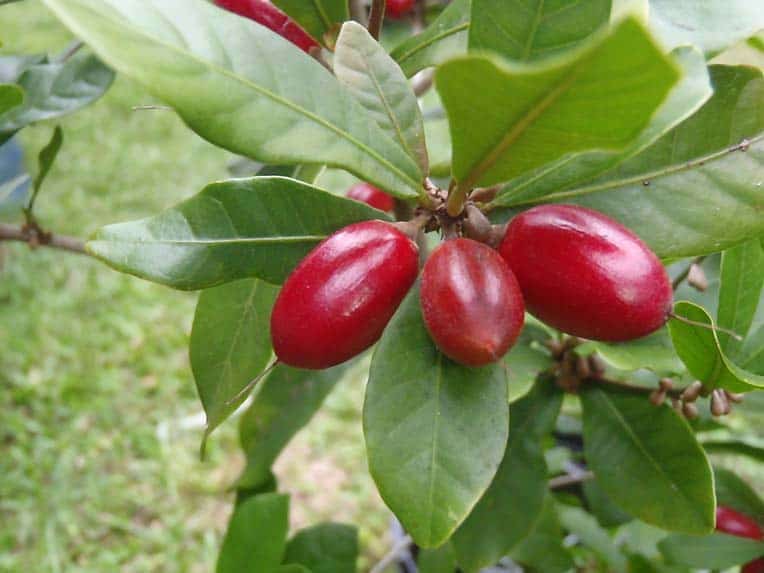Miracle fruits come from a plant called Synsepalum dulcificum1. These berries are famous because they can affect your perception of taste. As a result, acidic or sour food will taste deliciously sweet! Now, let’s see what are miracle berries and how miracle berries work!
Table of Contents
What are miracle berries?
Miracle berries are the fruits produced by Synsepalum dulcificum, a plant native from West Africa. This plant is a shrub with dense foliage producing white flowers and small fruits containing a single seed. The miracle fruit trees measure approximately 6 to 15 ft (2 – 4.5 m) and generally produce fruits twice a year, at the end of the raining season.
The European explorer Chevalier des Marchais first described this plant from an excursion in 1725. He noticed then that local people were chewing the fruit produced by this shrub before meals. Indeed, these people had found that miracle fruits could affect the perception of taste and naturally make acidic food taste sweet!
How do miracle berries work?
The active ingredient of miracle berries is a glycoprotein called Miraculin2. Although the prefix glyco refers to sugar, the protein itself does not taste sweet and the fruits have a low sugar content. Miraculin instead acts directly on the taste receptors for sweetness. This protein has a dual effect depending on the pH or acidity of the food. At high pH, the Miraculin will bind and block the receptors for sweetness. On the other hand, Miraculin can bind and activate the same receptors at low or acidic pH3,4. Therefore, these aliments will taste sweet. For example, lemons will magically taste like lemonade! Typically, you can expect this effect to last 30 minutes, but it can last up to 2 hours5.
Click here to see Frooties miracle fruit tablets on Amazon
How to grow miracle fruit?
This plant is native from Western Africa. It is a schrub that can grow 1.8–4.5 m (5.9–14.8 ft) in height. Synsepalum dulcificum grows in tropical regions, so it does not tolerate cold and must be maintained at relatively high temperatures and humidity. You are already considering to grow your own miracle fruits? Although you can easily find seeds online and this is a really cool idea, you should consider an important factor. According to Wikipedia, these plants will not yield fruits until they are 3-4 years old. Then they will start producing miracle fruits twice a year. Each of these red fruits measure 2 cm (0.79 in) long1.
Check these miracle fruit plants on Amazon
Where to buy miracle berry?
For those of you that can’t grow this plant or can’t get their hands on fresh fruits, there is a much more convenient option! Indeed, you can buy miracle berry tablets or pills. There are many different brands or products out there such as mBerry and Frooties. You should not chew these tablets. Instead, let it dissolve on your tongue and enjoy the magic of miracle fruits! For a more authentic experience, you can also get freeze dried fruits to have a real taste of these miracle berries. Check the image links in this post to find all the different products available (affiliate).
What to eat with miracle berries?
There are many amazing ways to discover the effect or miracle fruits on your tastebuds. The idea is of course to try different acidic and sour food or drinks. Here is a non-exhaustive list of ideas to make your experience even more impressive! Let us know your experience with miracle berries in the comments. Have you tried any of these or do you have other cool ideas?
Fruits and vegetables:
Of course, lemons are a must and they will taste like a delicious lemonade! Other citrus such as grapefruits and oranges are also interesting. In addition, pineapples are delicious. Some people even enjoy pickles and other vinegar-based products like mustard.
Check these mBerry Miracle Fruit Tablets on Amazon
Candies and chips:
Sour Patch or any other sour or citrus candies will do the trick. It is definitely another thing you must try! Bitter dark chocolate as well as salt and vinegar chips will also give nice results.
Alcohol and drinks:
Why not pair miracle berries with your favorite alcohol! Among other things, you can try Guinness beer or cider. Non alcoholic beverages such as soft drinks also give a nice effect. You should consider trying Sprite, 7up, tonic water or even Coke!
Are miracle berries safe?
Although the FDA does not approve its use as a food additive or sweetener, it can be sold as a dietary supplement. There is also no study indicating any potential adverse effect of miracle fruit ingestion. The effect is rather very inoffensive as it only affects the taste bud receptors and doesn’t seem to have any other physiological effects. On the other hand, miracle berries can be useful for cancer patients under chemotherapy or radiation therapy. These patients often find food tasteless and miracle berries can help them to improve palatability and regain appetite6.
Conclusion
Miracle fruits or Miraculin tablets are definitely worth the try. It is amazing to see how these fruits can modify your tasting perception. In addition, miracle fruits are the perfect way to sweeten an evening with friends! I hope that you will enjoy this tasty scientific experiment!
Check my previous posts to see how to use an ultrasonic diffuser to get all the benefits of aromatherapy or to learn how to use a microscope and how does it work.
References
- Synsepalum dulcificum‘s Wikipedia page
- Miraculin’s Wikipedia page
- Complete purification and characterization of the taste-modifying protein, miraculin, from miracle fruit. J Biol Chem. 1988 Aug 15;263(23):11536-9.
- Intracellular acidification is required for full activation of the sweet taste receptor by miraculin. Sci Rep. 2016; 6: 22807.
- Human sweet taste receptor mediates acid-induced sweetness of miraculin. Proc Natl Acad Sci U S A. 2011 Oct 4; 108(40): 16819–16824.
- Pilot Study of “Miracle Fruit” to Improve Food Palatability for Patients Receiving Chemotherapy. CJON 2012, 16(5), E173-E177

